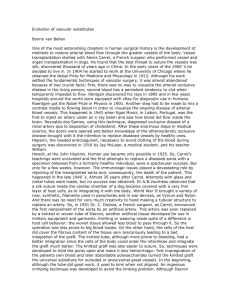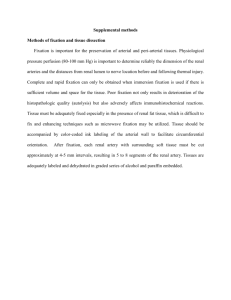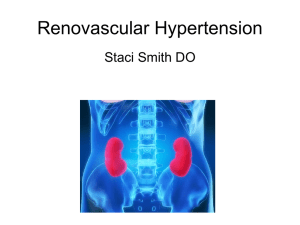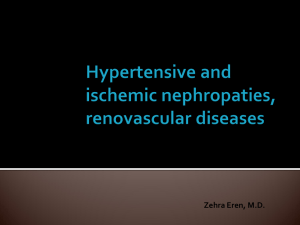Vascular Diagnostic Testing Part 2 Lower Extremities and Renal
advertisement
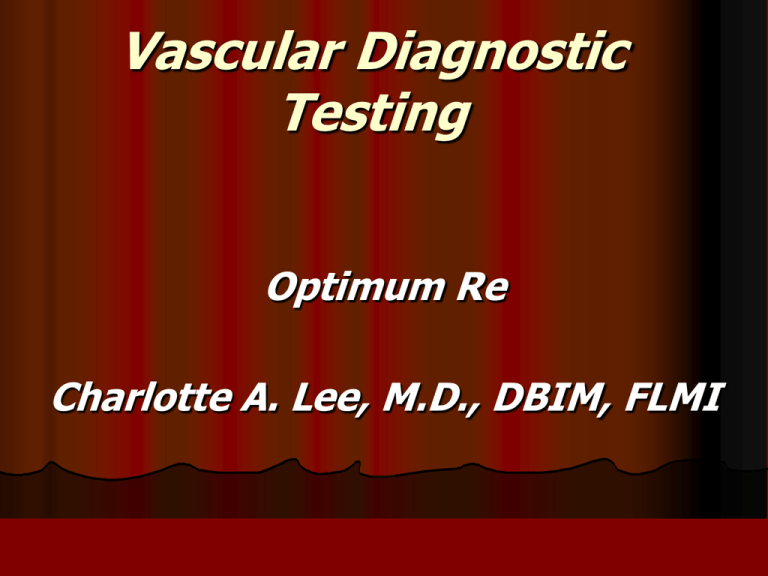
Vascular Diagnostic Testing Optimum Re Charlotte A. Lee, M.D., DBIM, FLMI Vascular Diagnostic Testing Part 2 Lower Extremities and Renal Arteries Charlotte A. Lee, M.D. Screening Venous and arterial Duplex Lower extremity Doppler Aortic ultrasound Renal artery ultrasound Vein and arterial graft surveillance Dialysis access surveillance Evaluation of: Aorta Common femoral artery Superficial femoral artery Proximal deep femoral artery Popliteal artery Common and external iliac arteries Tibial arteries Abdominal Aorta Transverse and longitudinal views—proximal, mid and distal aorta Transverse view of common iliac arteries at the aortic bifurcation Documentation of aneurysms, if present—measured outer wall to outer wall Abdominal Aorta Abdominal Aorta 3-D CTA of AAA Recommended Surveillance Less than 3 cm—no further testing 3-4 cm—Every 12 months 4.0-4.5 cm—Every 6 months > 4.5 cm—Referral to vascular subspecialist Indications for Repair Aneurysm >5.5 cm in diameter Expansion of >0.6 to 0.8 cm/year Renal Artery Stenosis General population 0.1% Hypertensive population 4.0 % HTN and suspected CAD 10-20 % Malignant HTN 20-30 % Malignant HTN and renal insufficiency 30-40% Prevalence increases with age: 7% over 65 yrs. RAS: Progression of atherosclerotic lesions Testing Gold standard = Invasive renal arteriography Indicated when clinical suspicion high and results of noninvasive testing inconclusive Magnetic Resonance Angiography Increasingly used as first line screening test Shows the renal arteries and perirenal aorta Two small studies showed a sensitivity of 100% and specificity of 71-96% when compared to arteriography Not useful for diagnosis of fibromuscular dysplasia that typically affects the middle and distal portions of the renal artery CT angiography Shows renal arteries and perirenal aorta Generally felt to have a sensitivity of 98% and specificity of 94% Variable sensitivity in FMD Disadvantage: Nephrotoxic Duplex Doppler Ultrasonography Provides both anatomical and functional assessment of renal arteries Stenotic lesions are detected by comparing flow velocities of the renal artery to the aorta In patients with high pretest probability of having RAS , sensitivity and specificity of 98% Disadvantages: time consuming (2 hours), highly operator dependent Fibromuscular dysplasia Frequently involves the distal 2/3 of the renal artery and branches Characterized by “string of beads” appearance due to alternating fibromuscular webs and aneurysmal dilatation Total occlusion uncommon Atherosclerosis Usually involves the proximal 1/3 of the main renal artery and perirenal aorta In advanced cases, segmental and diffuse intrarenal atherosclerosis observed, particularly in ischemic nephropathy Renal Vein Thrombosis Renal Vein Thrombosis—CT Peripheral Circulation Arterial Circulation Ankle-Brachial Index (ABI) Used to predict the severity of peripheral arterial disease Ratio of the blood pressure in the lower legs to the blood pressure in the arms; the BP in the ankle is normally the same or greater than the BP in the arms Determined by dividing the SBP in the arteries at the ankle/foot by the higher of the two SBP’s in the arms Procedure Measurements are taken at rest Usually repeated after 5 minutes of walking on a treadmill* * Even a slight drop in the ABI with exercise signals a high probability of PAD Interpretation of ABI Ratio of the highest ankle to brachial artery pressure >1.3 is considered abnormal <1.0 is considered abnormal Abnormal result suggests calcification of the walls of the arteries, thus leading to incompressible vessels Interpretation of ABI >1.2 Abnormal vessel hardening from PVD 1.0-1.2 Normal range 0.9-1.0 Acceptable 0.8-0.9 Some arterial disease 0.5-0.8 Moderate arterial disease <0.5 Severe arterial disease Limitations > 1.3 indicates that vessels are so sclerotic/calcified that they cannot be compressed for accurate BP readings Does not specifically identify which arteries are affected Segmental BP’s Segmental leg pressure measurements with pulse-volume recordings Yesenko, S. L. et al. Circulation 2007;115:e624-e626 Copyright ©2007 American Heart Association Predictability of ABI Studies in 2006 suggest that an abnormal ABPI may be an independent predictor of mortality, as it reflects the burden of atherosclerosis 1,2 Venous Insufficiency Screening Venous Valves Purpose To evaluate the deep and superficial venous systems for evidence of valvular incompetence Indications Pre-op evaluation Venous ulcers Lower extremity pain or heaviness Visible varicose veins Pain, edema, discoloration Contraindications and Limitations Obesity Open draining ulcers Severe edema Inability to stand for an extended length of time (patient has to be in reverse Trendelenberg or standing) May be seated for below-the-knee testing Direct Method Duplex evaluation for reflux to include 2-D structure and motion in real-time, color flow imaging, and Doppler US signal documentation Indirect Method Photoplethysmographic sensors—vein is emptied and the filling time is recorded (venous refill time or VRT) Results If abnormal VRT normalizes with application of tourniquet above the kneeincompetence of GSV If VRT remains abnormal, but normalizes with tourniquet below the knee, LSV incompetence is suggested If still abnormal, deep venous incompetence is suggested Deep Vein Thrombosis (DVT) Due to acute or chronic thrombophlebitis, frequently due to injury Chronic stagnation leading to phlebothrombosis Studies Duplex ultrasound Venogram—injection of contrast dye with radiographic imaging References 1. 2. Feringa HH, Bax JJ, van Waning VH et al. (March 2006). “ The long-term prognostic value of the resting and postexercise ankle-brachial index”. Arch Intern. Med. 166 (5): 529-35 Wild SH, Byrne CD, Smith FB, Lee AJ, Fowkes FG (March 2006). “Low anklebrachial pressure index predicts increased risk of cardiovascular disease independent of the metabolic syndrome and conventional cardiovascular risk factors in the Edinburgh Artery Study”. Diabetes Care 29(3): 637-42.
